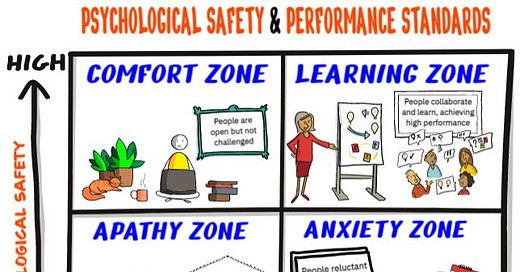How Amy Edmondson's Psychological Safety Can Benefit Your Organization
Performance Standards Matter
As an Agile leader in your organization, you know that accountability and high performance are essential to achieving your goals. However, achieving this balance can be difficult, especially when team members are afraid to speak up or take risks. This is where the concept of psychological safety comes into play.
Psychological safety refers to a workplace environment where employees feel safe to speak their minds and take risks without fear of negative consequences. This idea was first introduced by Harvard Business School professor Amy Edmondson, who observed that organizations that prioritize psychological safety tend to perform better and innovate more.
So, how can you apply psychological safety in your organization? First and foremost, it starts with leadership. As a leader, you must be willing to listen to your team members, encourage them to speak up, and support their ideas. You should also be transparent about your decision-making process and provide regular feedback to your team.
Second, you must create a culture of trust and openness. This means establishing clear communication channels, encouraging collaboration, and fostering a sense of community among your team members. It also means encouraging teams to take risks, make mistakes, and learn from them without fear of retribution.
Finally, you must be willing to invest in your employees' development. This means providing them with the necessary resources and training to succeed in their roles and supporting their growth and career aspirations.
By prioritizing psychological safety in your organization, you can create a workplace environment that encourages innovation, collaboration, and high performance. But how do you know if you're making progress?
According to Amy Edmondson, there are four distinct zones of psychological safety and performance standards:
Learning Zone: High psychological safety and high standards result in a high-performing team that is comfortable asking questions and discussing issues. People collaborate and get innovative and complex work done.
Anxiety Zone: High standards are enforced, but psychological safety is lacking, leading to potential errors and mistakes not being reported. People are reluctant to present new ideas or ask for help, putting the work at risk.
Comfort Zone: High psychological safety but low accountability results in teams that are not high-performing. People are open to change but are not challenged.
Apathy Zone: Low standards for performance and low psychological safety lead to an apathetic workplace where employees work for personal gain and do not collaborate. People are physically at work, but their minds are elsewhere, choosing self-protection over effort.
By understanding these zones, you can better assess your organization's level of psychological safety and identify areas for improvement. Can knowledge of these zones help in your workplace?
In conclusion, psychological safety is a powerful concept that can transform your organization's culture and performance. By prioritizing trust, openness, and employee development, you can create a workplace environment that encourages innovation and collaboration, and ultimately drives success for your organization.




